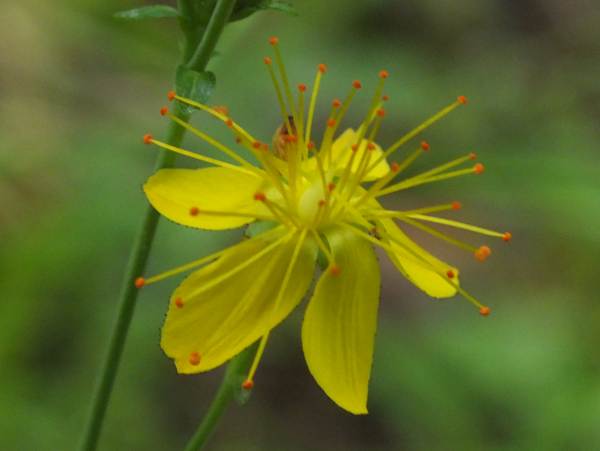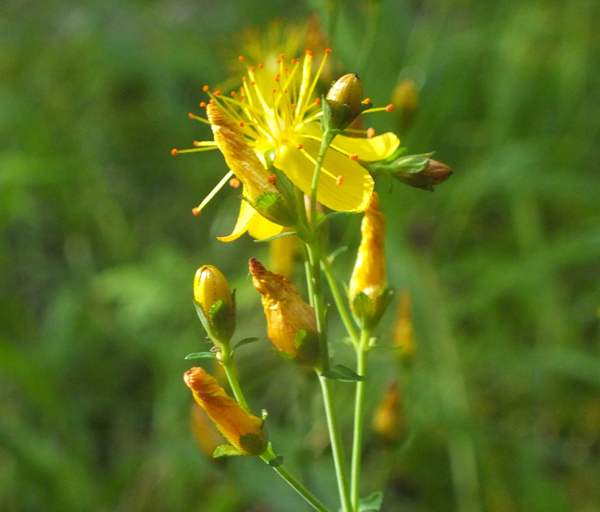Hypericum pulchrum - Slender St John's-wort
Phylum: Magnoliophyta - Class: Equisetopsida - Order: Malpighiales - Family: Hypericaceae

The perennial plant commonly referred to as Slender St John's-wort is one of several superficially similar Hypericum species that are native to Britain, Ireland and much of mainland Europe
Description
This erect hairless perennial grows to a height of 20 to 50cm. Its smooth round stems have just a few pairs of alternate bluntly oval leaves that almost clasp the stem; and the stem tips bear lax inflorescences in the form of panicles of flowers typically 12 to 18mm across. Each flower has five bright yellow petals which are often reddish on their undersides and have tiny red and black gland dots along their margins. Behind the petals are five green sepals, also with black dots on their marginal edges. Each flower has hree styles and several long stamens with orange anthers.

Habitat
Slender St John's-wort grows in neutral to acidic grassland such as on heaths, roadside verges, woodland edges, scrubby waste ground and beside hedgerows; it even occurs in some grey dunes (vegetated sand dunes furthest from the seashore with low or zero alkalinity and significant humus content)

Flowering times
In Britain and Ireland Slender St John's-wort can usually be seen in bloom from late June through to the end of August.
Etymology
The genus name Hypericum comes from the Greek hyper, meaning above, and eikon, meaning picture; it reflects the fact that these plants were hung above pictures in the belief that this would sefve to ward off evil spirits. The specific epithet pulchrum means pretty or handsome.
The common name also deserves some explanation. These flowers are guaranteed to be at their peak around Midsummer;s Day (21st June) and they have a long and ancient history associated with various festivals and processions that have taken place (and still do in some European countries) around this time of the year. The Feast of St. John the Baptist takes place around the same time - 24th June - and from this the plant was given the common name that is still used today and which superseded other names given to the plant in ancient times when it was used in Pagan rituals at mid-summer.
Similar species
Throughout Britain, Ireland and most of northern/central mainland Europe, several St. John's-wort species grow both in the wild and as cultivated plants in gardens. One of the most beautiful of the European species that grows in the wild is Hypericum olympicum, which has very large flowers measuring up to 5.5 cm in diameter. Hypericum calycinum, more commonly known to us as Rose of Sharon, originates in the Near East, and has even larger flowers - around 7 cm in diameter - and this is the species most familiar to us from gardens and parks in Britain and Ireland; it is an agressive shrub which has become widely naturalised in the countryside and can often be seen on roadside banks and verges and beside railway lines.
Other species from the UK include Trailing St. John's-wort Hypericum humifusum, Marsh St. John's-wort Hypericum elodes), and Perforate St. John's-wort Hypericum perforatum. The so-called perforations which give the latter species its name refer to translucent dots on the leaves of the plant, which look like holes when held up to the light.
Sue Parker's latest ebook is a revised and enlarged second edition of the acclaimed Wildflowers in the Algarve - an introductory guide. Full details here...
Buy it for just £3.95 on Amazon...
Please Help Us: If you have found this information interesting and useful, please consider helping to keep First Nature online by making a small donation towards the web hosting and internet costs.
Any donations over and above the essential running costs will help support the conservation work of Plantlife, the Rivers Trust and charitable botanic gardens - as do author royalties and publisher proceeds from books by Pat and Sue.



